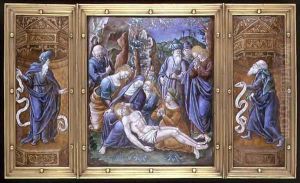Pierre Raymond Paintings
Pierre Raymond, also known as Pierre Reymond, was a notable French enameler from Limoges, a city in France renowned for its enamel work since the late Middle Ages. Born in 1602, Raymond was part of a family of enamelers that played a significant role in the development and continuation of the enamel tradition in Limoges. The city's enamelers were famous for their intricate work, often using a technique known as painted enamel, which involved applying colored vitreous enamel paste onto a metal surface, then firing it to create a glossy, decorative finish.
Raymond's career flourished in the 17th century, a period that saw a decline in the prominence of Limoges enamels due to changing tastes and the rise of other artistic centers in Europe. Despite this, Raymond and his workshop continued to produce high-quality enamel pieces that were sought after by collectors. He is particularly known for his plaques, dishes, and especially for his religious triptychs, which were small, portable altarpieces favored by the devout for private worship. Raymond's work is characterized by its fine detail, vibrant colors, and the use of gilding to enhance the richness of the pieces.
While not as widely known today as some other artists of his time, Pierre Raymond's enamels represent a significant achievement in the history of decorative arts. His work is preserved in various museums and collections, where it is studied for its craftsmanship and style. Raymond's legacy continued through his descendants and other apprentices who maintained the enameling tradition of Limoges. He passed away in 1684, leaving behind a body of work that continues to be appreciated for its beauty and technical excellence.

